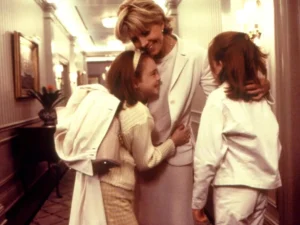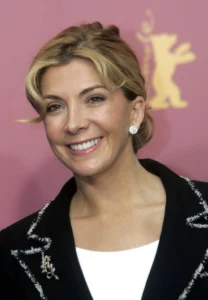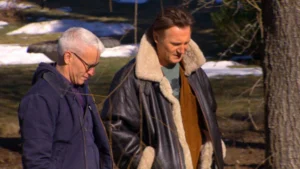Natasha Richardson’s Tragic Death—How a Simple Accident Turned Fatal
Natasha Richardson was best known for her roles on Broadway and in movies like The Parent Trap. Sadly, she passed away on March 18, 2009, after a skiing accident in Quebec left her with a severe brain injury.
Natasha Richardson’s Tragic Death
“Oh darling, I’ve taken a tumble in the snow,” Natasha Richardson told her husband, actor Liam Neeson, after falling while skiing in Quebec. She felt fine at the time, but this simple fall would soon lead to her tragic death at the age of 45.

Richardson didn’t think the fall was serious. She was more experienced as an actress than as a skier—having won a Tony Award for her role in Cabaret and starring in movies like The Parent Trap (1998) and Maid in Manhattan (2002). But on March 16, 2009, she took to the slopes of Mont Tremblant ski resort with enthusiasm.
At around noon, she was skiing on a beginner’s slope called Nansen, which was known for its gentle turns. As she neared the bottom of the hill, she fell and hit her head on the hard snow. But she quickly stood up and brushed it off.
Even though she thought she was fine, she wasn’t wearing a helmet, and the fall concerned her instructor. The ski patrol was alerted, and they called an ambulance. However, Richardson believed she was not in danger. She declined medical help and walked back to her hotel room. When the ambulance arrived a few minutes later, it left after learning she didn’t need assistance.

Sadly, her condition quickly worsened. Two days later, on March 18, 2009, Natasha Richardson passed away. The cause of her death was an epidural hematoma caused by her fall.
A Talented Actress From A Famous Family
Born on May 11, 1963, in London, Natasha Richardson came from a famous acting family. Her grandfather, Michael Redgrave, was a well-known Shakespearean actor. Her parents were actress Vanessa Redgrave and film director Tony Richardson.
Richardson was drawn to acting from a young age. At just four years old, she appeared in The Charge of the Light Brigade (1968), a film directed by her father and starring her mother. Later, she attended the Royal Central School of Speech and Drama to refine her skills.

According to the Los Angeles Times, Richardson worked hard to build her career without relying on her famous family name. She started with small roles before landing bigger ones.
Natasha Richardson In The Parent Trap
In 1988, she played the lead role in Patty Hearst, a film about the real-life kidnapping of an heiress. In 1990, she starred in a movie adaptation of The Handmaid’s Tale. Three years later, she played Zelda Fitzgerald, the wife of writer F. Scott Fitzgerald, in the film Zelda.
That same year, she got her big break on Broadway. She starred in the play Anna Christie, where she performed alongside Liam Neeson. The two fell in love, and Richardson, who was married at the time, divorced her husband and married Neeson in 1994.
Together, they had two sons, Micheál (born in 1995) and Daniel (born in 1996). Richardson balanced her career and family life. In 1998, she became widely known for playing Elizabeth James in The Parent Trap. Everything seemed perfect—until her tragic skiing accident in March 2009.
How A Fall Led To Natasha Richardson’s Death
On March 16, 2009, Natasha Richardson was skiing at Mont Tremblant in Quebec, Canada. She was not an experienced skier, so she took a lesson with an instructor on a beginner slope called Nansen.
The slope was not dangerous—it had a gentle incline and was ideal for beginners. But around noon, as Richardson reached the bottom of the hill, she fell and hit her head hard on the packed snow.
For beginner skiers, falls are common. However, Richardson was not wearing a helmet, and her instructor was concerned. The instructor called ski patrol, who then contacted an ambulance. Richardson, however, insisted she was fine. By 1:10 p.m., she even signed a waiver refusing medical help and walked back to her hotel, which was just 300 yards away.
By 1:30 p.m., Richardson was in her room, and the ambulance left without treating her.
“She did not show any visible signs of injury, but the ski patrol followed strict procedures and took her to the bottom of the slope and advised her to see a doctor,” the ski resort later explained, according to ABC News.
Right after her fall, Richardson seemed fine. She even called Neeson, who was in Toronto, and casually told him, “Oh darling, I’ve taken a tumble in the snow.”

However, by 3 p.m., she developed a headache and started feeling confused. An ambulance was called again, and paramedics quickly realized that the situation was serious. They took her to the Centre Hospitalier Laurentien in Sainte-Agathe.
At first, she seemed stable. Her vital signs were normal, and she was breathing well with oxygen. But her confusion worsened, so she was transferred to a larger hospital in Montreal.
By then, the situation had become critical. Neeson was told to come immediately. When he arrived, it was too late.
Richardson was brain dead.
In a 2014 interview with Anderson Cooper, Neeson recalled the devastating moment. “You didn’t need to be a rocket scientist to see what was happening,” he said. “It was like a cartoon—the brain was squashed up against the side of the skull.”
Liam Neeson Talks About Natasha Richardson’s Death
He continued, “I went in to her and told her I loved her. I said, ‘Sweetie, you’re not coming back from this. You’ve banged your head. I don’t know if you can hear me, but this is what happened. We’re bringing you back to New York.’”
That’s exactly what he did. Richardson was flown to New York City, where she was surrounded by family and friends. On March 18, 2009, just two days after her fall, she was taken off life support and passed away. The cause of death was an epidural hematoma.
Could Natasha Richardson’s Death Have Been Prevented?
After her passing, many wondered if her death could have been avoided. If she had gone to the hospital sooner, could she have survived?
ABC News reported that doctors had mixed opinions. One expert said that stopping the bleeding in her brain might have saved her life. But another pointed out that people fall while skiing all the time. Even if Richardson had been examined right away, the brain bleed might not have been visible yet.
For her family, the “what ifs” didn’t matter. Neeson focused on grieving, raising their sons, and moving forward.
“It was never real. It still kind of isn’t,” he told Anderson Cooper.
“Grief is like a wave. It hits you, and you feel unstable, like a three-legged table. The Earth doesn’t feel steady anymore. And then, over time, it passes and happens less often. But I still feel it sometimes.”
Despite the tragedy, Neeson found comfort in the fact that Richardson’s organs—her heart, kidneys, and liver—were donated to help save others.
“It’s terrific,” Neeson said. “And I think she would be very happy about that.”
